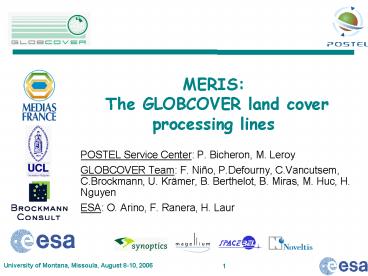MERIS: The GLOBCOVER land cover processing lines
1 / 16
Title: MERIS: The GLOBCOVER land cover processing lines
1
MERIS The GLOBCOVER land cover processing lines
- POSTEL Service Center P. Bicheron, M. Leroy
- GLOBCOVER Team F. Niño, P.Defourny, C.Vancutsem,
C.Brockmann, U. Krämer, B. Berthelot, B. Miras,
M. Huc, H. Nguyen - ESA O. Arino, F. Ranera, H. Laur
2
Objective
- The GLOBCOVER project started in April 2005 and
will end in June 2007 - Develop and demonstrate a service of production
of a global land cover map for 2005 - at 300 m resolution using MERIS
- with FAO Land Cover Classification System
- Two deliverables
- A hardware software automatised system
- Two validated products
- Time composited surface reflectances over Dec.
2004 and June 2006 - Thematic classes map
3
Processing line scheme
4
Overview
- The GLOBCOVER lines represents a major effort and
improvement in the processing of MERIS FR
products - Spectral Surface Reflectances are generated with
a - better geometric accuracy than current MERIS
products, - better cloud/shadow detection,
- a new compositing method
5
Geometry requirement
- Geometric properties requirements
- Co-registration of MERIS products RMSE error lt
150m - Absolute geo-location RMSE error lt 150m
- Tools
- Geo-location AMORGOS 2.0
- Quality assessment MEDICIS
Correlation points
Local translation that maximize similarity
measurements between images
6
Geometric performance
- Relative validation
- Sites Madagascar, Spain, Tunisia, Romania,
Poland Season all - 146 couples MERIS
- Absolute validation
- Site Madagascar, Spain
Season summer - First results on 10 Landsat images
- Conlusions
- RMSE in lat and lon are similar gt no specific
problem - Standard deviation of RMSE is satifsfactory (i.e.
small) - Relative and absolute validation results meet
well Globcover specification (lt150m)
7
Atmospherical correction
- A Neural Network relying on MOMO method has been
selected because of good validation results
(ESA-Albedo map project) - The atmospheric correction is a complex process
- L1b radiance to reflectance conversion
- Aerosol correction requires aerosol optical
depths from MODIS-8 days - Gaseous absorption correction
- Ozone from ECMWF auxiliary data present at MERIS
L1b tie-points - O2 from b11/b10 ratio, H2O from B15/b14 ratio
- LUTs for transmission assessment
8
Atmospherical correction
Atm. Corrected RGB
L1B RGB
9
Cloud detection
- Two methods are used
- 1. Cloud Probability Method atmospherical scheme
MOMO (Preusker, Freie Universität Berlin) through
a neural network - CLEAR_1, CLOUD_1
- 2. Blue Bands Cloud Screening global thresholds
using 443, 753, 760, 865 nm - 4 states CLEAR_2, THIN CLOUD_2, DENSE_CLOUD_2 and
SNOW_2 - Final cloud detection combines both excluding
snow - Update to come for the end of 2006
- Pressure threshold depending on altitude
- Cloud shadow
- Using CTP instead of constant height
- Bright sand test
- Potential use of climatology (TBC)
- Spectral climatology, MERIS albedo map
10
BRDF Correction and Compositing
- For BRDF correction, two methods are used
- The Mean Composite (Vancutsem et al., 2002) is
processed as a first reference Surface Spectral
Reflectance on a compositing period equal to 51
days - The CYCLOPES (Hagolle et al., 2004) method is
then applied to detect valid Surface Spectral
Reflectance - Removal of Outliers (residual thin clouds,
aerosols, shadows) with an iterative procedure - Compositing
- A Mean is applied over the valid Surface
Spectral Reflectance for 3 temporal windows - Bi-Monthly (1st-15th and 16th to 30th)
- Monthly (centered on the 15th)
- Seasonal (4 seasons of 3 months)
11
First GlobCover 300 m Mosaic
Colored composition using 670nm, 865 nm, 550 nm
12
Turkey Bosphore Strait Colored composition (865
nm, 560 nm, 412 nm)
13
National focusNile Valley
Monthly composite (May) over a 2.5 x 2.5 area
14
Regional compositeFrance
- Seasonal composite (Sep-Nov 2005) over a 10 x 10
area
15
Regional composite Spain/Morocco
- Seasonal composite (Sep-Nov 2005) over a 10 x 10
area
16
Next milestones
- September 2006
- Monthly mosaics over Europe (1 year) and at
global scale (1 month) - GLOBCOVER landcover map over Europe (draft)
- December 2006
- Monthly mosaics global full year 2005
- GLOBCOVER landcover map global (draft)
- June 2007
- GLOBCOVER V1 landcover map global































